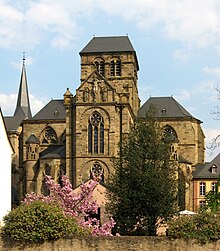| Church of Our Lady | |
|---|---|
Liebfrauenkirche | |
 | |
| Religion | |
| Affiliation | Roman Catholic |
| District | Diocese of Trier |
| Ecclesiastical or organizational status | Minor basilica |
| Location | |
| Location | Trier, Rhineland-Palatinate, |
| Geographic coordinates | 49°45′21″N 6°38′35″E / 49.755885°N 6.64315°E |
| Architecture | |
| Type | Church |
| Style | Gothic |
| Groundbreaking | c. 1230 AD |
| Completed | 1260 AD |
| Website | |
| liebfrauen-trier.de | |
| Official name | Church of Our Lady (Liebfrauenkirche) |
| Part of | Roman Monuments, Cathedral of St Peter and Church of Our Lady in Trier |
| Criteria | Cultural: (i), (iii), (iv), (vi) |
| Reference | 367-009 |
| Inscription | 1986 (10th Session) |
The Liebfrauenkirche (German for Church of Our Lady) in Trier, is, according to UNESCO, "the earliest church built in French High Gothic style outside France." It is designated as part of the Roman Monuments, Cathedral of St Peter and Church of Our Lady in Trier UNESCO World Heritage Site.[1] The Trier Dom (cathedral) is next to it, and the two buildings share a common wall.
- ^ UNESCO World Heritage Centre. "Roman Monuments, Cathedral of St Peter and Church of Our Lady in Trier". whc.unesco.org. Retrieved 5 February 2020.
The Church of Our Lady is the earliest church built in French High Gothic style outside France. Its purity of style (it was completed in only 30 years) and the undeviating implementation of the architect's plan for a basilica-shaped graduated central area, for which there were partial models, though no entire prototype in France, probably make it the most perfect example of the centralized construction concept in Gothic style